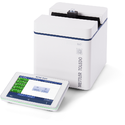 |
The white paper shares know-how in spectrophotometer calibration based on pharmacopeia requirements. |
Pharmacopeias are regulatory bodies which define guidelines on the procedures and analytical instrumentation for the preparation and analytical measurement of pharmaceutical products. Both the United States Pharmacopeia (USP) and European Pharmacopoeia (Ph. Eur.) have dedicated chapters in their respective pharmacopeias on the requirements of UV Vis spectrophotometers and the verification of their performance, namely spectrophotometer calibration. To ensure customers can comply with the changes in both pharmacopeias, which were already implemented in 2020, METTLER TOLEDO has adapted its automated performance verification accessories. This paper provides an overview of the important UV Vis spectroscopy-relevant changes in both the USP and Ph. Eur., taking a closer look at their impact and the solutions available to ensure compliance.
Why is UV Vis spectrophotometer calibration important?
It is important because instrument performance directly affects measurement accuracy and repeatability. For critical UV Vis measurements, especially in clinical, pharmaceutical, or industrial quality control, it is imperative that the instrument is performing according to its specification. In laboratories working according to pharmacopeia regulations (e.g. USP or Ph. Eur.), the instrument performance should be monitored regularly and documented accordingly.
What is Operational Qualification (OQ) for spectrophotometer?
OQ for spectrophotometer is normally comprised of the following tests as required by USP and Ph. Eur.
Photometric accuracy and repeatability, photometric linearity, stray light, wavelength accuracy, and repeatability, resolution.

What was revised from the previous versions to the latest versions of the European and United States Pharmacopeias?
On January 1st, 2020 the following changes in operational qualification became mandatory:
- The determination of the photometric linearity became mandatory in both pharmacopeias.
- In the newest edition of the USP, the stray light test according to procedure B, which is the specific wavelength method, is accepted in addition to procedure A, the solution filter ratio method. Both methods will be explained in chapter 2.3.4.
- In the newest issues of both pharmacopeias, the use of nicotinic acid (Niacin) for photometric qualification in the UV region in addition to the hitherto used potassium dichromate (PDC) is permitted.
- Both pharmacopeias demand qualification of the same optical parameters. The only exception is the test of photometric repeatability, which is required by the USP.





